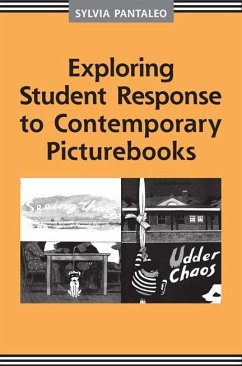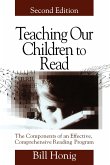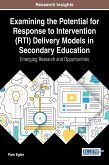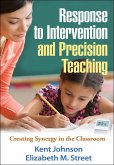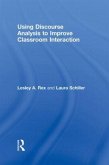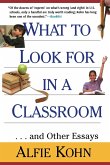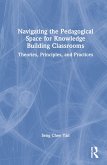Sylvia Pantaleo
Exploring Student Response to Contemporary Picturebooks
Sylvia Pantaleo
Exploring Student Response to Contemporary Picturebooks
- Gebundenes Buch
- Merkliste
- Auf die Merkliste
- Bewerten Bewerten
- Teilen
- Produkt teilen
- Produkterinnerung
- Produkterinnerung
Sylvia Pantaleo seeks to show the ways in which literature teaches artistic codes and conventions, critical thinking skills, visual literacy skills, and interpretative strategies.
Andere Kunden interessierten sich auch für
![Teaching Our Children to Read Teaching Our Children to Read]() Bill HonigTeaching Our Children to Read32,99 €
Bill HonigTeaching Our Children to Read32,99 €![Examining the Potential for Response to Intervention (RTI) Delivery Models in Secondary Education Examining the Potential for Response to Intervention (RTI) Delivery Models in Secondary Education]() Pam EplerExamining the Potential for Response to Intervention (RTI) Delivery Models in Secondary Education121,99 €
Pam EplerExamining the Potential for Response to Intervention (RTI) Delivery Models in Secondary Education121,99 €![Response to Intervention and Precision Teaching Response to Intervention and Precision Teaching]() Kent JohnsonResponse to Intervention and Precision Teaching63,99 €
Kent JohnsonResponse to Intervention and Precision Teaching63,99 €![Using Discourse Analysis to Improve Classroom Interaction Using Discourse Analysis to Improve Classroom Interaction]() Lesley A RexUsing Discourse Analysis to Improve Classroom Interaction197,99 €
Lesley A RexUsing Discourse Analysis to Improve Classroom Interaction197,99 €![What to Look for in a Classroom What to Look for in a Classroom]() Alfie KohnWhat to Look for in a Classroom23,99 €
Alfie KohnWhat to Look for in a Classroom23,99 €![Navigating the Pedagogical Space for Knowledge Building Classrooms Navigating the Pedagogical Space for Knowledge Building Classrooms]() Seng Chee TanNavigating the Pedagogical Space for Knowledge Building Classrooms174,99 €
Seng Chee TanNavigating the Pedagogical Space for Knowledge Building Classrooms174,99 €![The Student Enneagram The Student Enneagram]() Sarah Dutton WaxmanThe Student Enneagram37,99 €
Sarah Dutton WaxmanThe Student Enneagram37,99 €-
-
-
Sylvia Pantaleo seeks to show the ways in which literature teaches artistic codes and conventions, critical thinking skills, visual literacy skills, and interpretative strategies.
Hinweis: Dieser Artikel kann nur an eine deutsche Lieferadresse ausgeliefert werden.
Hinweis: Dieser Artikel kann nur an eine deutsche Lieferadresse ausgeliefert werden.
Produktdetails
- Produktdetails
- Verlag: University of Toronto Press
- Seitenzahl: 224
- Erscheinungstermin: 1. Oktober 2008
- Englisch
- Abmessung: 231mm x 160mm x 28mm
- Gewicht: 544g
- ISBN-13: 9780802097996
- ISBN-10: 0802097995
- Artikelnr.: 23346235
- Herstellerkennzeichnung
- Libri GmbH
- Europaallee 1
- 36244 Bad Hersfeld
- gpsr@libri.de
- Verlag: University of Toronto Press
- Seitenzahl: 224
- Erscheinungstermin: 1. Oktober 2008
- Englisch
- Abmessung: 231mm x 160mm x 28mm
- Gewicht: 544g
- ISBN-13: 9780802097996
- ISBN-10: 0802097995
- Artikelnr.: 23346235
- Herstellerkennzeichnung
- Libri GmbH
- Europaallee 1
- 36244 Bad Hersfeld
- gpsr@libri.de
Sylvia Pantaleo
Contents
Acknowledgments
Introduction: Exploring Student Response to Contemporary Picturebooks
1 Contextualizing Contemporary Picturebooks and Response to Literature
Text and Image in Picturebooks
Contemporary Picturebooks, Postmodernism, Metafiction and Radical Change
Metafiction
Metafictive Devices in The Three Pigs
Radical Change
Type One Radical Change - Changing Forms and Formats
Graphics in New Forms and Formats
Words and Pictures Reaching New Levels of Synergy
Nonlinear and Nonsequential Organization and Format
Multiple Layers of Meaning
Interactive Formats
Type Two Radical Change - Changing Perspectives
Multiple Perspectives, Visual and Verbal
Type Three Radical Change - Changing Boundaries
Unresolved Endings
Response to Literature
Interthinking and the Social Nature of Response
Reading Aloud to Children, Student Discussions, and Teacher Influence
The Social Nature of Intertextuality
2 Grade 1 Children, Three Porcines, and Four Voices
Research Site and Participants
Year One
Year Two
Research Methods
Year One
Year Two
Data Analysis
Year One
Year Two
The Three Pigs
Radical Change Characteristics
Type One Radical Change - Changing Forms and Formats
Graphics in New Forms and Formats
Words and Pictures Reaching New Levels of Synergy
Nonlinear and Nonsequential Organization and Format
Multiple Layers of Meaning
Interactive Formats
Type Two Radical Change - Changing Perspectives
Multiple Perspectives, Visual and Verbal
David Wiesner Fans
Voices in the Park
Radical Change Characteristics
Type One Radical Change - Changing Forms and Formats
Graphics in New Forms and Formats
Words and Pictures Reaching New Levels of Synergy
Nonlinear and Nonsequential Organization and Format
Multiple Layers of Meaning
Interactive Formats
Type Two Radical Change - Changing Perspectives
Multiple Perspectives, Visual and Verbal
Type Three Radical Change - Changing Boundaries
Unresolved Endings
Student Appreciation
Concluding Thoughts
3 Grade 1 Children, A Dreamer, Airborne Amphibians, and a Shortcut
Willy the Dreamer
Intertextuality
Metafictive Devices
Tuesday
Parody
Visual Parodies in Tuesday
Parody and the Young Reader
Shortcut
Metafictive Devices in Shortcut
Metafiction and the Child Reader
Using Talk as a Tool to Think Collectively
4 Grade 5 Students Reading Literature with Radical Change Characteristics
Research Site and Participants
Year Three
Year Four
Research Methods
Year Three
Year Four
Data Analysis
Small Group Discussions, Written Responses, and Student Interviews
Student Interviews About the Picturebooks
Year Three, Class 5A
Year Four, Class 5B
Year Four, Class 5C
Zoom and Re-zoom
Data Collection and Analysis
Students' Written Responses
Small Group Discussions
Discussion of Students' Written and Oral Responses
A Trio of Swines
A Collection of Fractured Fairy Tales
Falling into a Book of Fairy Tales
'Seeing Things,' 'Udder Chaos,' 'Problem Parents' and 'A Waiting Game'
Private Lessons
5 Grade 5 Students Writing Texts with Radical Change Characteristics
The Reader in the Writer
Eddie: Profile
The Three Weird Pigs and Other Awkward Stories
Intertextualities
Radical Change Characteristics
Eddie's Analysis
My Analysis
Jenatine: Profile
Red, Blue and Yellow
Intertextualities
Radical Change Characteristics
Alyssa's Analysis
My Analysis
Bert: Profile
The Three Little Spoons and the Big Bad Cow
Intertextualities
Radical Change Characteristics
Bert's Analysis
My Analysis
Overall Analysis of the Grade 5 Students' Stories/Books
Type One Radical Change - Changing Forms and Formats
Graphics in New Forms and Formats
Words and Pictures Reaching New Levels of Synergy
Nonlinear and Nonsequential Organization and Format
Multiple Layers of Meaning
Interactive Formats
Type Two Radical Change - Changing Perspectives
Multiple Perspectives, Visual and Verbal
Type Three Radical Change - Changing Boundaries
Unresolved Endings
Group and Gender Similarities and Differences
The Intertextual Nature of Texts and the Classroom Community
6 Contemporary Picturebooks and Collateral Learning
Contextualizing Narrative Structures
Collateral Learning
Appendix A: List of Metafictive Devices
Appendix B: A Sample of Picture Books Exhibiting Radical Change
Characteristics and/or Metafictive Devices
Appendix C: Picturebook and Novel Annotations
Appendix D: Favourite Picturebooks of 5A Students
Appendix E: Favourite Picturebooks of 5B Students
Appendix F: Favourite Picturebooks of 5C Students
Appendix G: Picturebooks 5A Students Found Challenging
Appendix H: Picturebooks 5B Students Found Challenging
Appendix I: Picturebooks 5C Students Found Challenging
Appendix J: Radical Change Characteristics in Five Students' Stories/Books
Appendix K: Overall Analysis of Grade 5 Students Stories/Books
References
Children's Literature References
Acknowledgments
Introduction: Exploring Student Response to Contemporary Picturebooks
1 Contextualizing Contemporary Picturebooks and Response to Literature
Text and Image in Picturebooks
Contemporary Picturebooks, Postmodernism, Metafiction and Radical Change
Metafiction
Metafictive Devices in The Three Pigs
Radical Change
Type One Radical Change - Changing Forms and Formats
Graphics in New Forms and Formats
Words and Pictures Reaching New Levels of Synergy
Nonlinear and Nonsequential Organization and Format
Multiple Layers of Meaning
Interactive Formats
Type Two Radical Change - Changing Perspectives
Multiple Perspectives, Visual and Verbal
Type Three Radical Change - Changing Boundaries
Unresolved Endings
Response to Literature
Interthinking and the Social Nature of Response
Reading Aloud to Children, Student Discussions, and Teacher Influence
The Social Nature of Intertextuality
2 Grade 1 Children, Three Porcines, and Four Voices
Research Site and Participants
Year One
Year Two
Research Methods
Year One
Year Two
Data Analysis
Year One
Year Two
The Three Pigs
Radical Change Characteristics
Type One Radical Change - Changing Forms and Formats
Graphics in New Forms and Formats
Words and Pictures Reaching New Levels of Synergy
Nonlinear and Nonsequential Organization and Format
Multiple Layers of Meaning
Interactive Formats
Type Two Radical Change - Changing Perspectives
Multiple Perspectives, Visual and Verbal
David Wiesner Fans
Voices in the Park
Radical Change Characteristics
Type One Radical Change - Changing Forms and Formats
Graphics in New Forms and Formats
Words and Pictures Reaching New Levels of Synergy
Nonlinear and Nonsequential Organization and Format
Multiple Layers of Meaning
Interactive Formats
Type Two Radical Change - Changing Perspectives
Multiple Perspectives, Visual and Verbal
Type Three Radical Change - Changing Boundaries
Unresolved Endings
Student Appreciation
Concluding Thoughts
3 Grade 1 Children, A Dreamer, Airborne Amphibians, and a Shortcut
Willy the Dreamer
Intertextuality
Metafictive Devices
Tuesday
Parody
Visual Parodies in Tuesday
Parody and the Young Reader
Shortcut
Metafictive Devices in Shortcut
Metafiction and the Child Reader
Using Talk as a Tool to Think Collectively
4 Grade 5 Students Reading Literature with Radical Change Characteristics
Research Site and Participants
Year Three
Year Four
Research Methods
Year Three
Year Four
Data Analysis
Small Group Discussions, Written Responses, and Student Interviews
Student Interviews About the Picturebooks
Year Three, Class 5A
Year Four, Class 5B
Year Four, Class 5C
Zoom and Re-zoom
Data Collection and Analysis
Students' Written Responses
Small Group Discussions
Discussion of Students' Written and Oral Responses
A Trio of Swines
A Collection of Fractured Fairy Tales
Falling into a Book of Fairy Tales
'Seeing Things,' 'Udder Chaos,' 'Problem Parents' and 'A Waiting Game'
Private Lessons
5 Grade 5 Students Writing Texts with Radical Change Characteristics
The Reader in the Writer
Eddie: Profile
The Three Weird Pigs and Other Awkward Stories
Intertextualities
Radical Change Characteristics
Eddie's Analysis
My Analysis
Jenatine: Profile
Red, Blue and Yellow
Intertextualities
Radical Change Characteristics
Alyssa's Analysis
My Analysis
Bert: Profile
The Three Little Spoons and the Big Bad Cow
Intertextualities
Radical Change Characteristics
Bert's Analysis
My Analysis
Overall Analysis of the Grade 5 Students' Stories/Books
Type One Radical Change - Changing Forms and Formats
Graphics in New Forms and Formats
Words and Pictures Reaching New Levels of Synergy
Nonlinear and Nonsequential Organization and Format
Multiple Layers of Meaning
Interactive Formats
Type Two Radical Change - Changing Perspectives
Multiple Perspectives, Visual and Verbal
Type Three Radical Change - Changing Boundaries
Unresolved Endings
Group and Gender Similarities and Differences
The Intertextual Nature of Texts and the Classroom Community
6 Contemporary Picturebooks and Collateral Learning
Contextualizing Narrative Structures
Collateral Learning
Appendix A: List of Metafictive Devices
Appendix B: A Sample of Picture Books Exhibiting Radical Change
Characteristics and/or Metafictive Devices
Appendix C: Picturebook and Novel Annotations
Appendix D: Favourite Picturebooks of 5A Students
Appendix E: Favourite Picturebooks of 5B Students
Appendix F: Favourite Picturebooks of 5C Students
Appendix G: Picturebooks 5A Students Found Challenging
Appendix H: Picturebooks 5B Students Found Challenging
Appendix I: Picturebooks 5C Students Found Challenging
Appendix J: Radical Change Characteristics in Five Students' Stories/Books
Appendix K: Overall Analysis of Grade 5 Students Stories/Books
References
Children's Literature References
Contents
Acknowledgments
Introduction: Exploring Student Response to Contemporary Picturebooks
1 Contextualizing Contemporary Picturebooks and Response to Literature
Text and Image in Picturebooks
Contemporary Picturebooks, Postmodernism, Metafiction and Radical Change
Metafiction
Metafictive Devices in The Three Pigs
Radical Change
Type One Radical Change - Changing Forms and Formats
Graphics in New Forms and Formats
Words and Pictures Reaching New Levels of Synergy
Nonlinear and Nonsequential Organization and Format
Multiple Layers of Meaning
Interactive Formats
Type Two Radical Change - Changing Perspectives
Multiple Perspectives, Visual and Verbal
Type Three Radical Change - Changing Boundaries
Unresolved Endings
Response to Literature
Interthinking and the Social Nature of Response
Reading Aloud to Children, Student Discussions, and Teacher Influence
The Social Nature of Intertextuality
2 Grade 1 Children, Three Porcines, and Four Voices
Research Site and Participants
Year One
Year Two
Research Methods
Year One
Year Two
Data Analysis
Year One
Year Two
The Three Pigs
Radical Change Characteristics
Type One Radical Change - Changing Forms and Formats
Graphics in New Forms and Formats
Words and Pictures Reaching New Levels of Synergy
Nonlinear and Nonsequential Organization and Format
Multiple Layers of Meaning
Interactive Formats
Type Two Radical Change - Changing Perspectives
Multiple Perspectives, Visual and Verbal
David Wiesner Fans
Voices in the Park
Radical Change Characteristics
Type One Radical Change - Changing Forms and Formats
Graphics in New Forms and Formats
Words and Pictures Reaching New Levels of Synergy
Nonlinear and Nonsequential Organization and Format
Multiple Layers of Meaning
Interactive Formats
Type Two Radical Change - Changing Perspectives
Multiple Perspectives, Visual and Verbal
Type Three Radical Change - Changing Boundaries
Unresolved Endings
Student Appreciation
Concluding Thoughts
3 Grade 1 Children, A Dreamer, Airborne Amphibians, and a Shortcut
Willy the Dreamer
Intertextuality
Metafictive Devices
Tuesday
Parody
Visual Parodies in Tuesday
Parody and the Young Reader
Shortcut
Metafictive Devices in Shortcut
Metafiction and the Child Reader
Using Talk as a Tool to Think Collectively
4 Grade 5 Students Reading Literature with Radical Change Characteristics
Research Site and Participants
Year Three
Year Four
Research Methods
Year Three
Year Four
Data Analysis
Small Group Discussions, Written Responses, and Student Interviews
Student Interviews About the Picturebooks
Year Three, Class 5A
Year Four, Class 5B
Year Four, Class 5C
Zoom and Re-zoom
Data Collection and Analysis
Students' Written Responses
Small Group Discussions
Discussion of Students' Written and Oral Responses
A Trio of Swines
A Collection of Fractured Fairy Tales
Falling into a Book of Fairy Tales
'Seeing Things,' 'Udder Chaos,' 'Problem Parents' and 'A Waiting Game'
Private Lessons
5 Grade 5 Students Writing Texts with Radical Change Characteristics
The Reader in the Writer
Eddie: Profile
The Three Weird Pigs and Other Awkward Stories
Intertextualities
Radical Change Characteristics
Eddie's Analysis
My Analysis
Jenatine: Profile
Red, Blue and Yellow
Intertextualities
Radical Change Characteristics
Alyssa's Analysis
My Analysis
Bert: Profile
The Three Little Spoons and the Big Bad Cow
Intertextualities
Radical Change Characteristics
Bert's Analysis
My Analysis
Overall Analysis of the Grade 5 Students' Stories/Books
Type One Radical Change - Changing Forms and Formats
Graphics in New Forms and Formats
Words and Pictures Reaching New Levels of Synergy
Nonlinear and Nonsequential Organization and Format
Multiple Layers of Meaning
Interactive Formats
Type Two Radical Change - Changing Perspectives
Multiple Perspectives, Visual and Verbal
Type Three Radical Change - Changing Boundaries
Unresolved Endings
Group and Gender Similarities and Differences
The Intertextual Nature of Texts and the Classroom Community
6 Contemporary Picturebooks and Collateral Learning
Contextualizing Narrative Structures
Collateral Learning
Appendix A: List of Metafictive Devices
Appendix B: A Sample of Picture Books Exhibiting Radical Change
Characteristics and/or Metafictive Devices
Appendix C: Picturebook and Novel Annotations
Appendix D: Favourite Picturebooks of 5A Students
Appendix E: Favourite Picturebooks of 5B Students
Appendix F: Favourite Picturebooks of 5C Students
Appendix G: Picturebooks 5A Students Found Challenging
Appendix H: Picturebooks 5B Students Found Challenging
Appendix I: Picturebooks 5C Students Found Challenging
Appendix J: Radical Change Characteristics in Five Students' Stories/Books
Appendix K: Overall Analysis of Grade 5 Students Stories/Books
References
Children's Literature References
Acknowledgments
Introduction: Exploring Student Response to Contemporary Picturebooks
1 Contextualizing Contemporary Picturebooks and Response to Literature
Text and Image in Picturebooks
Contemporary Picturebooks, Postmodernism, Metafiction and Radical Change
Metafiction
Metafictive Devices in The Three Pigs
Radical Change
Type One Radical Change - Changing Forms and Formats
Graphics in New Forms and Formats
Words and Pictures Reaching New Levels of Synergy
Nonlinear and Nonsequential Organization and Format
Multiple Layers of Meaning
Interactive Formats
Type Two Radical Change - Changing Perspectives
Multiple Perspectives, Visual and Verbal
Type Three Radical Change - Changing Boundaries
Unresolved Endings
Response to Literature
Interthinking and the Social Nature of Response
Reading Aloud to Children, Student Discussions, and Teacher Influence
The Social Nature of Intertextuality
2 Grade 1 Children, Three Porcines, and Four Voices
Research Site and Participants
Year One
Year Two
Research Methods
Year One
Year Two
Data Analysis
Year One
Year Two
The Three Pigs
Radical Change Characteristics
Type One Radical Change - Changing Forms and Formats
Graphics in New Forms and Formats
Words and Pictures Reaching New Levels of Synergy
Nonlinear and Nonsequential Organization and Format
Multiple Layers of Meaning
Interactive Formats
Type Two Radical Change - Changing Perspectives
Multiple Perspectives, Visual and Verbal
David Wiesner Fans
Voices in the Park
Radical Change Characteristics
Type One Radical Change - Changing Forms and Formats
Graphics in New Forms and Formats
Words and Pictures Reaching New Levels of Synergy
Nonlinear and Nonsequential Organization and Format
Multiple Layers of Meaning
Interactive Formats
Type Two Radical Change - Changing Perspectives
Multiple Perspectives, Visual and Verbal
Type Three Radical Change - Changing Boundaries
Unresolved Endings
Student Appreciation
Concluding Thoughts
3 Grade 1 Children, A Dreamer, Airborne Amphibians, and a Shortcut
Willy the Dreamer
Intertextuality
Metafictive Devices
Tuesday
Parody
Visual Parodies in Tuesday
Parody and the Young Reader
Shortcut
Metafictive Devices in Shortcut
Metafiction and the Child Reader
Using Talk as a Tool to Think Collectively
4 Grade 5 Students Reading Literature with Radical Change Characteristics
Research Site and Participants
Year Three
Year Four
Research Methods
Year Three
Year Four
Data Analysis
Small Group Discussions, Written Responses, and Student Interviews
Student Interviews About the Picturebooks
Year Three, Class 5A
Year Four, Class 5B
Year Four, Class 5C
Zoom and Re-zoom
Data Collection and Analysis
Students' Written Responses
Small Group Discussions
Discussion of Students' Written and Oral Responses
A Trio of Swines
A Collection of Fractured Fairy Tales
Falling into a Book of Fairy Tales
'Seeing Things,' 'Udder Chaos,' 'Problem Parents' and 'A Waiting Game'
Private Lessons
5 Grade 5 Students Writing Texts with Radical Change Characteristics
The Reader in the Writer
Eddie: Profile
The Three Weird Pigs and Other Awkward Stories
Intertextualities
Radical Change Characteristics
Eddie's Analysis
My Analysis
Jenatine: Profile
Red, Blue and Yellow
Intertextualities
Radical Change Characteristics
Alyssa's Analysis
My Analysis
Bert: Profile
The Three Little Spoons and the Big Bad Cow
Intertextualities
Radical Change Characteristics
Bert's Analysis
My Analysis
Overall Analysis of the Grade 5 Students' Stories/Books
Type One Radical Change - Changing Forms and Formats
Graphics in New Forms and Formats
Words and Pictures Reaching New Levels of Synergy
Nonlinear and Nonsequential Organization and Format
Multiple Layers of Meaning
Interactive Formats
Type Two Radical Change - Changing Perspectives
Multiple Perspectives, Visual and Verbal
Type Three Radical Change - Changing Boundaries
Unresolved Endings
Group and Gender Similarities and Differences
The Intertextual Nature of Texts and the Classroom Community
6 Contemporary Picturebooks and Collateral Learning
Contextualizing Narrative Structures
Collateral Learning
Appendix A: List of Metafictive Devices
Appendix B: A Sample of Picture Books Exhibiting Radical Change
Characteristics and/or Metafictive Devices
Appendix C: Picturebook and Novel Annotations
Appendix D: Favourite Picturebooks of 5A Students
Appendix E: Favourite Picturebooks of 5B Students
Appendix F: Favourite Picturebooks of 5C Students
Appendix G: Picturebooks 5A Students Found Challenging
Appendix H: Picturebooks 5B Students Found Challenging
Appendix I: Picturebooks 5C Students Found Challenging
Appendix J: Radical Change Characteristics in Five Students' Stories/Books
Appendix K: Overall Analysis of Grade 5 Students Stories/Books
References
Children's Literature References

